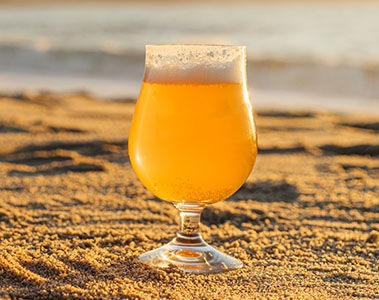
News
11月 8, 2022
気候変動による大麦の品質低下がアディショナル・ブルーイングに解決策を求める
気候変動による大麦の品質劣化に対抗するために、醸造家がどのような取り組みを行っているのか、製品アプリケーションのエキスパートであるテオ・ワイズマンが説明する。 続きを読む

Have you been wondering about the future of barley? Research suggest that climate-related weather extremes may threaten the yield and quality of the barley used to brew one of our most-loved beverages: beer. But brewers have not been idle, they have a plan!
For centuries, brewers have soaked barley in water until it sprouts so they could use the malt to create a great tasting beer. However, this age-old process is under threat, due to the overly fluctuating temperatures and variable weather patterns being experienced across the world. One of the more obvious impacts is on barley yield. It’s been known for centuries that yields of barley decline in periods of localized extreme drought and heat. What is striking, is that scientific researchers are now predicting a much more global reduction of barley yield due to climate change: by as much as 17 percent in the coming years, depending on the severity of the conditions. This in turn could lead to supply shortages and price spikes.

Barley quality will decline too
It’s not just the yield but the quality of barley that will be negatively affected by climate change. During specific growth stages of barley, if the temperature is too high or there is not enough rain, this in general leads to barley with three changed characteristics: a higher protein content, a lower extract yield, and a lower diastatic power3. Each of these has an impact on beer quality.
Higher protein content may result in beers that are more sensitive to haze formation, which leads to reduced beer stability. Lower extract yield means that the malt contains less starch to be converted to the correct amount of fermentable sugars needed to produce the correct amount of alcohol. As a result, more malt must be used to produce the same amount of beer. A lower diastatic power means that the malt contains reduced amounts of the enzymes such as alfa- and beta-amylase that are responsible for effective conversion of the available starch into fermentable sugars.

Two conventional solutions are not wholly effective
In the light of these challenges, how can brewers be prepared to secure the future availability of beer? One direction involves changing various process parameters in the brewing process. For example, it’s possible to extend the mashing duration so that as much extract is converted from the malt as possible. The downside of this is that it can have a negative impact on the production capacity of the brewery.
Another possibility is to solve the filtration problems that arise from poor malt quality and high viscosity. This could be done by a brewery accepting wort that is not as clear as normal, in order to keep capacity levels up. The drawback of this approach is that it will immediately have a negative impact on the quality, taste and flavor of the beer.
Two conventional solutions are not wholly effective
In the light of these challenges, how can brewers be prepared to secure the future availability of beer? One direction involves changing various process parameters in the brewing process. For example, it’s possible to extend the mashing duration so that as much extract is converted from the malt as possible. The downside of this is that it can have a negative impact on the production capacity of the brewery.
Another possibility is to solve the filtration problems that arise from poor malt quality and high viscosity. This could be done by a brewery accepting wort that is not as clear as normal, in order to keep capacity levels up. The drawback of this approach is that it will immediately have a negative impact on the quality, taste and flavor of the beer.
Use malt alternatives to mitigate barley yield and quality issues
At dsm-firmenich, our global brew masters have not been idle either. They have proactively developed a technological solution to help brewers reduce their dependence on barley. Brewers Compass® is an enzyme solution that enables brewing with up to 100% barley and is very suitable for blends of malt with barley and/or adjuncts such as rice, wheat, rye, or oats (which stimulates the cultivation of adjuncts and drives employment in emerging countries). Breweries can now produce a high-quality beer from unmalted barley far easier, more reliably and more cost-effectively than was previously possible.
"Switching from malted to unmalted barley brewing, cuts barley consumption by 10%. Brewing with unmalted barley also uses significantly less water and energy than the traditional barley malting process, which accounts for around 10-15% of the eco-footprint of a beer."
If you want to know more, please contact us and one of our brew masters will be delighted to talk with you about your specific brewing questions or requirements to help your brewery respond proactively to the negative impacts of climate change on barley yield and quality.

Beer Fact
Low-quality malt often contains high levels of beta glucan, which can heavily increase the viscosity of wort and/or beer, resulting in filtration problems. These eventually lead to capacity loss or an increase in operational costs.
大麦の将来について疑問に思ったことはないだろうか? 、気候に関連した異常気象が、私たちが最も愛する飲料のひとつであるビールの醸造に使用される大麦の収量と品質を脅かす可能性があることを、調査結果が示唆している。しかし、醸造業者たち 、彼らは怠慢ではなく、ある計画を立てている!
何世紀にもわたり、ビールメーカーは大麦を芽が出るまで水に浸し、麦芽を使っておいしいビールを造ってきた。 しかし、世界各地で経験されている過度な気温の変動や変わりやすい天候パターンのせいで、この古くからの製法が危機に瀕している。 より明白な影響のひとつは、大麦の収量だ。 大麦の収量が、局地的な極端な干ばつや暑さの期間中に減少することは、何世紀にもわたって知られてきた。 驚くべきは、科学研究者たちが現在、気候変動による大麦の収量減少を、条件の厳しさにもよるが、今後数年間で17%もの大幅な減少を予測していることだ。 これはひいては、供給不足と価格高騰につながる可能性がある。

大麦の品質も低下する
大麦の特定の生育段階において、気温が高すぎたり、雨が少なかったりすると、一般的に、タンパク質含量が高くなる、エキス収量が低下する、ジアスタティックパワーが低下するという3つの特性が変化する。
タンパク質含量が高いビールは、ヘイズ形成の影響を受けやすく、ビールの安定性が低下する可能性があります。 エキス収量が低いということは、麦芽に含まれるデンプンの量が少なく、適量のアルコールを生成するのに必要な適量の発酵性糖類に変換されないことを意味します。 その結果、同じ量のビールを製造するために、より多くの麦芽を使用する必要があります。 ジアスタティックパワーが低いということは、麦芽に含まれるアルファアミラーゼやベータアミラーゼなどの酵素の量が少なく、利用可能なデンプンを発酵性糖類に効果的に変換する役割を担っていることを意味します。

従来の2つの解決策は完全には有効ではない。
このような課題を踏まえて、ビールメーカーは将来のビールの供給力を確保するために、どのような準備ができるだろうか? 一つの方向性は、醸造工程における様々なプロセスパラメーターを変更することである。 例えば、麦芽からできるだけ多くのエキスを変換するために、マッシングの時間を延長することが可能である。 この欠点は、醸造所の生産能力に悪影響を及ぼす可能性があることである。
もうひとつの可能性は、麦芽の品質が悪く、粘度が高いために生じる濾過の問題を解決することである。 これは、容量レベルを維持するために、醸造所が通常ほど透明でない麦汁を受け入れることによって行うことができる。 この方法の欠点は、ビールの品質、味、風味に直ちに悪影響を及ぼすことである。
大麦の収量と品質の問題を軽減するために代替麦芽を使用する
DSMでは、世界の醸造マスターたちが、醸造家が大麦への依存を減らすための技術的ソリューションを積極的に開発している。 Brewers Compass® は、大麦100%までの醸造を可能にする酵素ソリューションで、麦芽と大麦および/または米、小麦、ライ麦、オーツ麦などの補助麦芽のブレンドに非常に適しています(これは補助麦芽の栽培を刺激し、新興国の雇用を促進します)。醸造所は現在、麦芽のない大麦から高品質のビールを、従来よりもはるかに簡単に、より確実に、より高いコスト効率で製造することができます。
「麦芽から無麦芽に切り替えることで、大麦の消費量を10%削減することができます。 また、無麦芽で醸造することで、ビールのエコフットプリントの約10~15%を占める従来の大麦麦芽製造プロセスよりも、水とエネルギーの使用量を大幅に削減することができます」。
もっと詳しくお知りになりたい方は、 までご連絡ください。 、当社の醸造マスターが喜んで、 、お客様の具体的な醸造に関するご質問やご要望についてお話させていただきます。 、お客様の醸造所が気候変動による大麦の収量や品質への悪影響に積極的に対応できるよう、お手伝いさせていただきます。

ビール・ファクト
低品質の麦芽にはベータグルカンが多量に含まれていることが多く、麦汁やビールの粘度を大きく上昇させ、濾過の問題を引き起こします。 これらは最終的に、生産能力の低下や操業コストの増加につながります。
dsm-ファーメニッヒ・ソリューション
Brewers Compass® を使用することで、ビールメーカーは泡立ち、味わい、透明感に優れた高品質のビールを実現することができ、麦芽の割合の代わりとして麦芽未使用の大麦をビールに使用することによるコストメリットも得ることができる。


